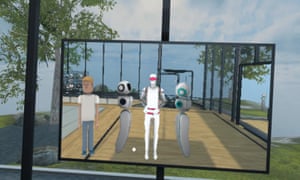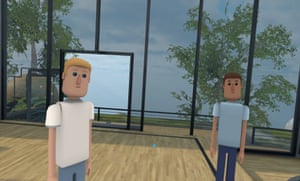
I’m standing in front of a decorative garden talking to a guy from Germany about PC specifications. This is not really what I was hoping for from the future of online social communication.
The place I’m in is AltSpace, a virtual reality social world. It was launched in 2013 by AltSpaceVR, a small startup based in Redwood City, California. Although it’s early days for virtual reality as a consumer phenomenon, there’s been a lot of interest in the idea of virtual chatrooms – AltSpace VR has already attracted more than $15m (£10.6m) in venture capital funding, and Mark Zuckerberg has talked about multi-user VR as the future of social media. There are alternatives to AltSpace, such as vTime and VRChat but this one is getting a lot of interest due to its multi-platform compatibility and array of features. That’s why I decided to don a HTC Vive and spend an hour in the virtual world of chat.
It’s been … odd.
When you boot up AltSpace you’re dropped into the welcome area. It’s a sort of futuristic living room complete with huge windows looking out over a peaceful, neatly trimmed garden. I keep expecting Kevin McCloud to pop by and tell me how much it cost to build. On one wall there’s a vast screen that gives hints on how to customise and name your avatar. On another, there’s a menu display that shows different rooms and areas to explore. There’s a diary of social get-togethers so you can meet up for karaoke or to play, say, Dungeons and Dragons. There are also special events such as standup comedy evenings and talks. In a couple of days time, for example, Emmy-nominated writer and comedian Heather Anne Campbell will be here doing virtual improv with Miles Stroth.
Organisers of real-life events can also arrange to stream live footage into AltSpace – there’s even a plush cinema viewing room where you can stand and watch. Facebook streamed the recent Oculus Connect 2 conference into the world.

I’m here at 8.30am on a Thursday so it’s not exactly Piccadilly Circus. There are a few avatars roaming around the welcome room; some look like droids, some like blank-eyed cartoon men. I’ve gone with a sort of Asimov-style android in a white jumpsuit and pink sunglasses. This is basically what I wear in real-life anyway so I feel pretty comfortable.
When you hit an area, you can immediately hear everyone else chatting. The Vive and Rift headsets both have built-in mics so chatting is easy – and when you’re talking the name above your avatar lights up so people can tell it’s you. It’s also possible to bring up a little on-screen menu of emojis so you can make a smiley face or high-five symbol appear above your head. There is no escaping the emoji, even in virtual space.
At first, I start chatting with a post-production special effects manager based in Chicago. We do what people have always done in chatrooms: compare locations. We don’t have to ask about age or sex because those come through, to some extent, in our voices. That’s the first really intriguing thing about VR chat – if you talk, it’s harder to disguise your gender; you’re giving away much more real-world information about yourself. An AltSpace veteran told me that the VR community is overwhelmingly male and so when a female voice is heard it attracts a lot of interest.
Here’s where things get potentially uncomfortable. You can move in the world with a joypad or by pointing your head at an area of the map and instantly transporting there. If you’re using an HTC Vive you can move around by actually walking but it’s quicker to just direct your cursor and teleport. When people do that to you they pop up right into your vicinity, and it’s super intimidating. Some get really close and you can find yourself in the middle of a huddle. Although it’s not really your body, you feel your personal space being pressed and pushed at. The polite barriers we put up in ‘meatspace’ (as cyberpunk authors used to call the real world), don’t yet exist in the virtual space. I can’t imagine how different that experience will be for a woman, I just know that I found myself stepping away from other avatars on several occasions.
At the same time, there’s no aural intimacy. If you’re in the same room with other people, you can hear everyone chatting at once and there’s little positional detail (even though the Rift and Vive support that function), so everyone is more-or-less the same volume. If there’s more than two people it’s a wall of chat. It’s likely that this will improve but it means, although you can be physically intimate in terms of body space, you can’t whisper. Maybe that’s a good thing, I don’t know.
The other weird thing is, you think you’re in the same space but you’re not: AltSpace users get different features depending on the tech they’re using. For example, in the welcome space, I could see a mirror on the wall that let me see my own avatar as well as everyone else in view but it didn’t show up for people who weren’t using Vive. “You get this interesting social hierarchy forming,” says Dan Page of Opposable VR, who was kind enough to lend me the tech. “You have users who are on Vive, on Rift, on Gear, and you can also use AltSpace on a 2D screen. But when I use Vive, other people can see the controllers represented on screen so they crowd round and ask me about the technology. Also anyone using the Leap Motion actually have visible hands on-screen. It’s like a technological class system.”
Page dons a Gear VR headset and we wander the space together. There’s a room where you can play frisbee golf and a decorative garden maze to explore. Things are pretty empty – we pass an Australian man and woman, who seem to be trying to help each other navigate but there aren’t many other people around. Page says the most people he’s seen in a room is 25, and that’s pretty common. “If you go on at around six in the evening, it tends to be at least 15 people,” he said. “I’ve bumped into people I know on Twitter. Quite often you meet the AltSpace community staff, they’re around quite a lot explaining the features of the space.”
For the most part though, I meet other men messing about with their new VR toys. The guy from Germany is fascinated that I’m using the Vive. When I tell him I’m a journalist he wants to know if the Vive is the best headset I’ve tried. Then the guy from Chicago teleports over and suddenly they’re discussing PC specifications and whether Valve is planning a VR-compatible version of its Steam Machine platform. I realise that I am in a VR chat space having the sort of conversation that I could have at any real-world tech event with the same kind of people who would be there. It’s the sort of conversation I would desperately wish myself out of in meatspace, but in VR I can just bring up another menu, select a different room and, whoosh, I’m gone.
That is definitely a good thing. There are clearly a whole bundle of social rules and conventions that will need to be formed and regulated in these spaces – especially as a wider array of people come onboard. Imagine a Twitter storm in this space; imagine a troll; imagine being dog-piled when you can see and hear everyone yelling at you. It is possible to mute another user by pointing at the name icon above their avatar and clicking on the ‘ignore’ button, but if there’s more than one harasser it’ll take time. I suppose there’s a chance people will behave with more civility in virtual space where telepresence inevitably creates a different social atmosphere. I’m not sure I’d bet on that, though.

On the flipside, there is amazing potential here to bring likeminded people together in a way that replicates a lot of the social cues and parameters of the real world. Everything from social hangouts to business meetings are easily facilitated. I can imagine this will be fun, exciting and, well, sociable. Relationships will be formed, social barriers will be dropped, ideas will be generated.
Of course, we’ve had online virtual worlds like Second Life for years, and they’ll provide some clues on how this will all pan out – but in VR the dynamics feel very different – more intimate. As a games writer, I’ve seen how online multiplayer games have become interesting spaces that allow friends to chat about lots of stuff they may not be able to in real life – perhaps places such as AltSpace will be the same. Perhaps telepresence therapy will become a thing.
But it’s all so strange at the moment because our brains are still adapting to this brave new world. It is crazy to be both embodied and not embodied in a space. To have the visual cues of physical intimacy without any physical intimacy at all. There were times when I cocked my ear towards another speaker in the room to hear them better. Of course it made no difference but some part of me thought it would. All those little indicators of mood and intention that accompany our movements and facial expressions in the real world are lost here. We have our voices and weird, unresponsive metal bodies. We are souls in an alien world.
I did not want to talk about PC specifications. I wanted to talk about what the hell all this is going to mean when everyone else arrives.
[Source:- Gurdian]

